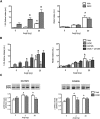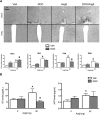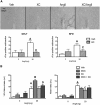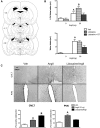The role of the hypothalamic paraventricular nucleus and the organum vasculosum lateral terminalis in the control of sodium appetite in male rats
- PMID: 25009258
- PMCID: PMC4087205
- DOI: 10.1523/JNEUROSCI.3979-13.2014
The role of the hypothalamic paraventricular nucleus and the organum vasculosum lateral terminalis in the control of sodium appetite in male rats
Abstract
Angiotensin II (AngII) and aldosterone cooperate centrally to produce a robust sodium appetite. The intracellular signaling and circuitry that underlie this interaction remain unspecified. Male rats pretreated with both deoxycorticosterone (DOC; a synthetic precursor of aldosterone) and central AngII exhibited a marked sodium intake, as classically described. Disruption of inositol trisphosphate signaling, but not extracellular-regulated receptor kinase 1 and 2 signaling, prevented the cooperativity of DOC and AngII on sodium intake. The pattern of expression of the immediate early gene product cFos was used to identify key brain regions that may underlie this behavior. In the paraventricular nuclei (PVN) of the hypothalamus, DOC pretreatment diminished both AngII-induced cFos induction and neurosecretion of oxytocin, a peptide expressed in the PVN. Conversely, in the organum vasculosum lateral terminalis (OVLT), DOC pretreatment augmented cFos expression. Immunohistochemistry identified a substantial presence of oxytocin fibers in the OVLT. In addition, when action potentials in the PVN were inhibited with intraparenchymal lidocaine, AngII-induced sodium ingestion was exaggerated. Intriguingly, this treatment also increased the number of neurons in the OVLT expressing AngII-induced cFos. Collectively, these results suggest that the behavioral cooperativity between DOC and AngII involves the alleviation of an inhibitory oxytocin signal, possibly relayed directly from the PVN to the OVLT.
Keywords: aldosterone; angiotensin; oxytocin; receptor signaling; sodium appetite.
Copyright © 2014 the authors 0270-6474/14/349249-12$15.00/0.
Figures





Similar articles
-
Integration of Hypernatremia and Angiotensin II by the Organum Vasculosum of the Lamina Terminalis Regulates Thirst.J Neurosci. 2020 Mar 4;40(10):2069-2079. doi: 10.1523/JNEUROSCI.2208-19.2020. Epub 2020 Jan 31. J Neurosci. 2020. PMID: 32005766 Free PMC article.
-
Intra-carotid hyperosmotic stimulation increases Fos staining in forebrain organum vasculosum laminae terminalis neurones that project to the hypothalamic paraventricular nucleus.J Physiol. 2008 Nov 1;586(21):5231-45. doi: 10.1113/jphysiol.2008.159665. Epub 2008 Aug 28. J Physiol. 2008. PMID: 18755745 Free PMC article.
-
Dietary sodium deprivation evokes activation of brain regional neurons and down-regulation of angiotensin II type 1 receptor and angiotensin-convertion enzyme mRNA expression.Neuroscience. 2009 Dec 15;164(3):1303-11. doi: 10.1016/j.neuroscience.2009.08.064. Epub 2009 Sep 4. Neuroscience. 2009. PMID: 19733634
-
Signal Transduction of Mineralocorticoid and Angiotensin II Receptors in the Central Control of Sodium Appetite: A Narrative Review.Int J Mol Sci. 2021 Oct 29;22(21):11735. doi: 10.3390/ijms222111735. Int J Mol Sci. 2021. PMID: 34769164 Free PMC article. Review.
-
Neurochemical Circuits Subserving Fluid Balance and Baroreflex: A Role for Serotonin, Oxytocin, and Gonadal Steroids.In: De Luca LA Jr, Menani JV, Johnson AK, editors. Neurobiology of Body Fluid Homeostasis: Transduction and Integration. Boca Raton (FL): CRC Press/Taylor & Francis; 2014. Chapter 9. In: De Luca LA Jr, Menani JV, Johnson AK, editors. Neurobiology of Body Fluid Homeostasis: Transduction and Integration. Boca Raton (FL): CRC Press/Taylor & Francis; 2014. Chapter 9. PMID: 24829993 Free Books & Documents. Review.
Cited by
-
Astrocytes in the Ventrolateral Preoptic Area Promote Sleep.J Neurosci. 2020 Nov 18;40(47):8994-9011. doi: 10.1523/JNEUROSCI.1486-20.2020. Epub 2020 Oct 16. J Neurosci. 2020. PMID: 33067363 Free PMC article.
-
Neuronal (pro)renin receptor regulates deoxycorticosterone-induced sodium intake.Physiol Genomics. 2018 Oct 1;50(10):904-912. doi: 10.1152/physiolgenomics.00065.2018. Epub 2018 Aug 24. Physiol Genomics. 2018. PMID: 30142028 Free PMC article.
-
Brain anatomy of the 4-day-old European rabbit.J Anat. 2018 May;232(5):747-767. doi: 10.1111/joa.12789. Epub 2018 Feb 14. J Anat. 2018. PMID: 29441579 Free PMC article.
-
Localisation of 11β-Hydroxysteroid Dehydrogenase Type 2 in Mineralocorticoid Receptor Expressing Magnocellular Neurosecretory Neurones of the Rat Supraoptic and Paraventricular Nuclei.J Neuroendocrinol. 2015 Nov;27(11):835-49. doi: 10.1111/jne.12325. J Neuroendocrinol. 2015. PMID: 26403275 Free PMC article.
-
Mechanisms of brain renin angiotensin system-induced drinking and blood pressure: importance of the subfornical organ.Am J Physiol Regul Integr Comp Physiol. 2015 Feb 15;308(4):R238-49. doi: 10.1152/ajpregu.00486.2014. Epub 2014 Dec 17. Am J Physiol Regul Integr Comp Physiol. 2015. PMID: 25519738 Free PMC article. Review.
References
-
- Beresford MJ, Fitzsimons JT. Intracerebroventricular angiotensin II-induced thirst and sodium appetite in rat are blocked by the AT1 receptor antagonist, losartan (Dup753), but not by the AT2 antagonist, CGP 42112A. Exp Physiol. 1992;77:761–764. - PubMed
Publication types
MeSH terms
Substances
Grants and funding
LinkOut - more resources
Full Text Sources
Other Literature Sources
Medical
